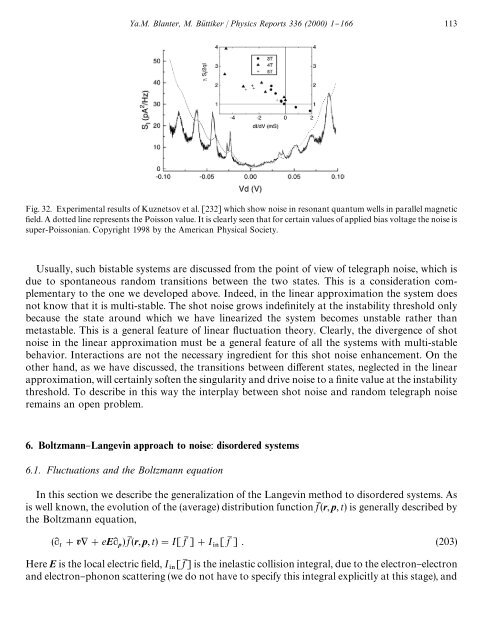shot noise in mesoscopic conductors - Low Temperature Laboratory
shot noise in mesoscopic conductors - Low Temperature Laboratory
shot noise in mesoscopic conductors - Low Temperature Laboratory
Create successful ePaper yourself
Turn your PDF publications into a flip-book with our unique Google optimized e-Paper software.
Fig. 32. Experimental results of Kuznetsov et al. [232] which show <strong>noise</strong> <strong>in</strong> resonant quantum wells <strong>in</strong> parallel magnetic<br />
"eld. A dotted l<strong>in</strong>e represents the Poisson value. It is clearly seen that for certa<strong>in</strong> values of applied bias voltage the <strong>noise</strong> is<br />
super-Poissonian. Copyright 1998 by the American Physical Society.<br />
Usually, such bistable systems are discussed from the po<strong>in</strong>t of view of telegraph <strong>noise</strong>, which is<br />
due to spontaneous random transitions between the two states. This is a consideration complementary<br />
to the one we developed above. Indeed, <strong>in</strong> the l<strong>in</strong>ear approximation the system does<br />
not know that it is multi-stable. The <strong>shot</strong> <strong>noise</strong> grows <strong>in</strong>de"nitely at the <strong>in</strong>stability threshold only<br />
because the state around which we have l<strong>in</strong>earized the system becomes unstable rather than<br />
metastable. This is a general feature of l<strong>in</strong>ear #uctuation theory. Clearly, the divergence of <strong>shot</strong><br />
<strong>noise</strong> <strong>in</strong> the l<strong>in</strong>ear approximation must be a general feature of all the systems with multi-stable<br />
behavior. Interactions are not the necessary <strong>in</strong>gredient for this <strong>shot</strong> <strong>noise</strong> enhancement. On the<br />
other hand, as we have discussed, the transitions between di!erent states, neglected <strong>in</strong> the l<strong>in</strong>ear<br />
approximation, will certa<strong>in</strong>ly soften the s<strong>in</strong>gularity and drive <strong>noise</strong> to a "nite value at the <strong>in</strong>stability<br />
threshold. To describe <strong>in</strong> this way the <strong>in</strong>terplay between <strong>shot</strong> <strong>noise</strong> and random telegraph <strong>noise</strong><br />
rema<strong>in</strong>s an open problem.<br />
6. Boltzmann}Langev<strong>in</strong> approach to <strong>noise</strong>: disordered systems<br />
6.1. Fluctuations and the Boltzmann equation<br />
Ya.M. Blanter, M. Bu( ttiker / Physics Reports 336 (2000) 1}166 113<br />
In this section we describe the generalization of the Langev<strong>in</strong> method to disordered systems. As<br />
is well known, the evolution of the (average) distribution function fM (r, p, t) is generally described by<br />
the Boltzmann equation,<br />
(R #*#eER p) fM (r, p, t)"I[ fM ]#I [ fM ] . (203)<br />
Here E is the local electric "eld, I [ fM ] is the <strong>in</strong>elastic collision <strong>in</strong>tegral, due to the electron}electron<br />
and electron}phonon scatter<strong>in</strong>g (we do not have to specify this <strong>in</strong>tegral explicitly at this stage), and
















